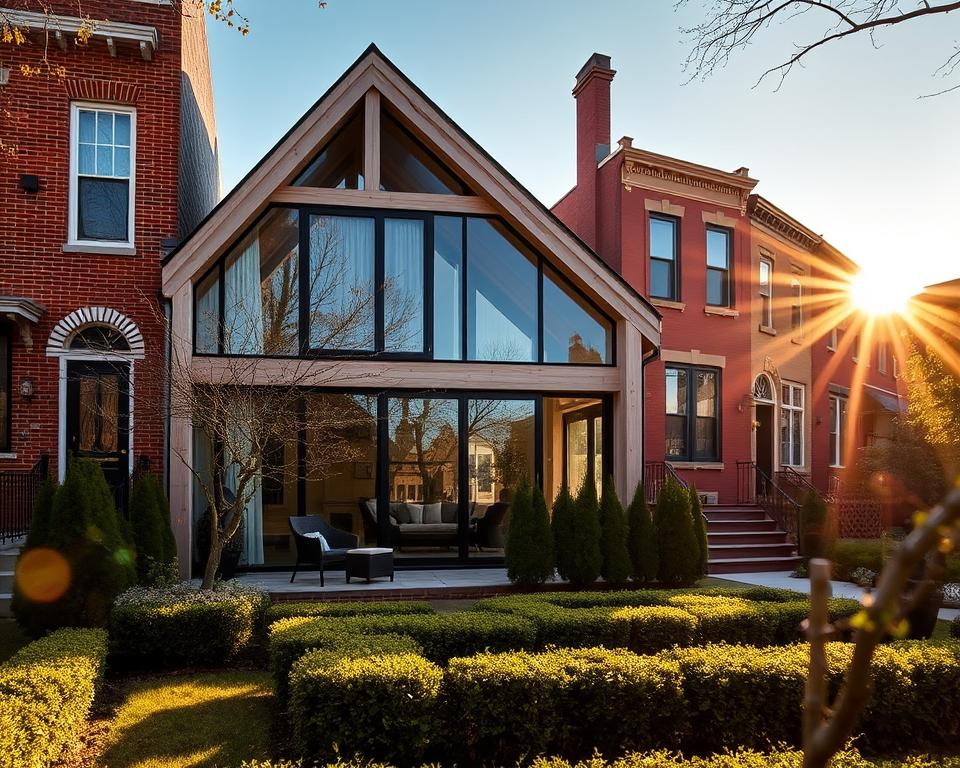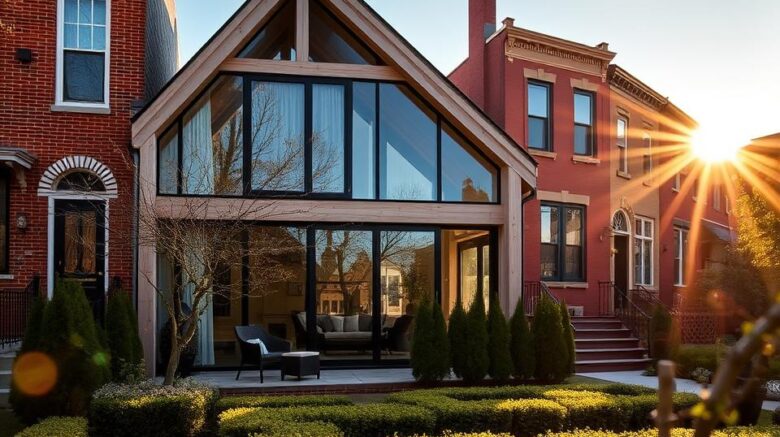Earth Bound Building: Straw-bale Homebuilding in Montgomery
Have you heard that residences constructed from green building materials may cut energy costs by as much as 50%? It’s one key reason why more homeowners are turning to eco-conscious design. Earth Bound Building, based in Montgomery, leads this movement, focused on forward-thinking and low-energy projects.
Through the use of renewable materials like straw bales in timber frames, Earth Bound Building delivers timber frame construction Montgomery that remain not only environmentally friendly and incredibly durable. This approach blends time-honored craftsmanship with current ecological practices, so that every project meets the top standards of sustainability.
Why Earth Bound Building stands out comes from their craftsman-led method and strong community involvement. They collaborate with homeowners to craft spaces that express their principles and needs. For those seeking a eco-conscious way to build, Earth Bound Building is your go-to partner in Montgomery.
Understanding Strawbale Building?
Straw, often seen as waste, is revolutionizing eco-design. Straw bale construction utilizes stacking bales within timber frames to form walls that are simultaneously highly insulating and structural. The technique uses an agricultural byproduct, which makes it a regenerative and eco-friendly choice.
Straw is derived from grain crops such as wheat, rice, or barley. In place of burning or discarding it, farmers can sell it for construction. This reduces agricultural waste and offers a sustainable material for homes. It’s a simple process, perfect for owner-builders and community projects.
One of the distinctive features of straw bale walls is their insulation performance. Compared to traditional materials like fiberglass or wood, straw bales deliver a higher R-value. This means they retain heat better, leading to lower energy costs. See a quick comparison:

| Material Type | R-Value (per inch) |
|---|---|
| Straw Bale | R-2.38 |
| Fiberglass | R-2.20 |
| Wood | R-1.41 |
Another advantage is the use of low-toxin materials. Straw bales are absent of harmful chemicals, promoting cleaner indoor air quality. That makes them a wise choice for families and environmentally conscious homeowners.
In summary, straw bale construction is a low-impact, high-efficiency, and health-conscious option. It’s a perfect fit for those seeking to reduce their environmental footprint while gaining long-term savings.
Why Select Earth Bound Building for Your Project?
Choosing the right team for your sustainable project is crucial. Earth Bound Building is a leader in eco-friendly design, offering advanced solutions tailored to your needs. Their approach integrates leading techniques with a profound respect for the environment.
Commitment to Sustainability
Earth Bound Building emphasizes sustainable practices in every project. They use CO₂-locking straw and reduced-impact materials to minimize environmental impact. Beyond helping the planet but also supports long-term savings for homeowners.
Their collaborations with regional farmers ensure ethically sourced materials. By strengthening local agriculture, they contribute to a circular economy. This commitment to sustainability differentiates them in the industry.
Local Expertise in Montgomery
With strong connections in Montgomery, Earth Bound Building understands the unique needs of the area. They are experienced in local climate conditions, permitting processes, and supply chains. This expertise delivers smooth project execution and compliance with regulations.
Their custom designs fit Montgomery’s aesthetic preferences while satisfying strict building codes. Whether it’s a residential or commercial project, they produce results that harmonize with the local environment.
| Category | Earth Bound Building | Traditional Practices |
|---|---|---|
| Sourcing of Materials | Local, ethically sourced straw | Imported, high-embodied energy materials |
| Energy Efficiency | High R-value insulation | Standard insulation |
| Environmental Impact | Low carbon footprint | Higher emissions |
Earth Bound Building’s commitment to sustainability and local expertise makes them the ideal choice for your next project. Their progressive practices and locally engaged approach ensure a seamless and eco-friendly experience.
The Upsides of Straw bale Building Montgomery
Green building is on the rise for its ability to merge innovation with environmental responsibility. One of the most compelling methods in this field is the use of straw bales. This approach offers a range of benefits, from energy efficiency to eco-friendliness, which makes it an attractive option for modern homeowners.
Energy Efficiency and Cost Savings
Straw bale walls deliver exceptional insulation, beating traditional materials such as fiberglass. With an R-value of 2.38 per inch, they balance indoor temperatures, cutting the need for heating and cooling. This can produce energy savings of up to 50-75%.
Over time, these savings offset the initial construction costs. Homeowners benefit from lower energy bills while supporting a greener planet. Here’s how straw bales measure up to other materials:
| Material | Thermal R-Value/inch |
|---|---|
| Strawbale | R-2.38 |
| Fiberglass | R-2.20 |
| Wood | R-1.41 |
Eco-Friendly and Renewable
Straw is a regenerative resource that is harvested every year, unlike timber, which takes decades to mature. Using straw in construction cuts down on agricultural waste and fosters a circular economy. It also locks in CO₂ in the walls, helping to fight climate change.
Additionally, straw bale walls are low-toxin, supporting better indoor air quality. They are also highly fire safe, with plastered walls exceeding 2-hour fire ratings. This makes them a secure and responsible choice for any project.
By choosing straw bale construction, you’re not just building a home—you’re investing in a cleaner, more sustainable future.
How Straw bale Homes Are Constructed
There are multiple ways to construct sustainable homes using straw bales. Each method provides unique benefits, from structural support to streamlined installation. Knowing these approaches can help you choose the best approach for your project.
Nebraska Style vs. In-Fill Wall Systems
The Nebraska Style is a traditional method where straw walls serve as the primary structural support. This approach is well-suited for smaller homes and focuses on simplicity. The bales are stacked directly on the foundation, eliminating the need for additional supports or frames.
In contrast, In-Fill Wall Systems use timber frames to carry the structural load. The bales are installed within these frames, providing faster roof installation and enhanced design flexibility. This method is preferred for larger projects where customization is key.
Prefabricated Straw Wall Panels
Prefabricated panels are a next-gen innovation in straw bale construction. These factory-built wall sections minimize on-site man-hours and minimize weather-related risks. They are designed for quick assembly, making them a practical choice for time-sensitive projects.
Here is a comparison of the three methods:
| Method | Key Features | Best For |
|---|---|---|
| Nebraska Style | Load-bearing bales, simple build | Small homes |
| In-Fill Systems | Timber frames, design flexibility | Larger projects |
| Prefabricated Panels | Factory-built, reduced labor | Quick installations |
Each method has its strengths, and the choice is guided by your project’s needs. Whether you choose traditional techniques or modern innovations, straw bale construction offers a sustainable and effective solution.
Common Myths About Straw-bale Construction
Many people misunderstand sustainable materials like straw. These myths frequently deter homeowners from exploring eco-friendly options. Let’s debunk some of the most common concerns.
Fire Resistance and Safety
One of the biggest myths is that straw is a fire hazard. In reality, compressed bales lack the oxygen needed to burn. Lab tests show that plastered straw walls can withstand 2+ hours of fire exposure. This exceeds the fire resistance of many traditional materials like lumber.
Plaster acts as a protective barrier, sealing the bales and inhibiting ignition. This renders straw-based structures very safe. Here’s a quick comparison:
| Material | Fire Rating |
|---|---|
| Plastered Straw | 2+ hours |
| Wood | 1 hour |
Pest and Moisture Management
Another concern is pests. Straw has little to no nutritional value, which discourages rodents and insects. When sealed with plaster, it becomes nearly impossible for pests to penetrate. This neutralizes one of the most common concerns homeowners worry about.
Moisture is also addressable with proper design. Elevated foundations, wide eaves, and breathable finishes like vapor-permeable stucco reduce the risk of rot. Modern techniques support that these homes remain durable for decades.
See how straw compares to traditional materials in moisture control:
| Assembly | Moisture Control |
|---|---|
| Straw with Proper Design | High |
| Wood without Treatment | Low |
By countering these myths, it’s clear that straw-based structures are a sound, responsible, and durable choice for modern homes.
Is a Straw-bale Home Right for You?
Creating a home that’s both appealing and sustainable is well within reach. With unique features like thick window niches and sweeping designs, eco-friendly homes provide endless possibilities. Here’s why this could be the perfect choice for you.
Customization and Aesthetic Appeal
One of the standout features of these homes is their design flexibility. You can create organic walls, arched doorways, and built-in shelving to suit your style. The thick walls also offer strong acoustic privacy, keeping interiors tranquil.
Rustic plaster finishes add a unique charm, blending modern aesthetics with natural elements. Whether you’re an artist or an eco-conscious family, these homes can be crafted to mirror your personality and needs.
Long-Term Benefits and Sustainability
Choosing a sustainable home isn’t just about the environment—it’s also a smart financial decision. These homes have lower upkeep over time, thanks to their energy efficiency. With decreased heating and cooling bills, you’ll see meaningful savings on utilities.
Additionally, green homes may be eligible for tax incentives and command higher property values. Here is a quick comparison of lifecycle costs:
| Cost Area | Strawbale Homes | Conventional Homes |
|---|---|---|
| Energy Costs | Lower | Higher |
| Maintenance | Minimal | Regular |
| Property Value | Higher | Standard |
Earth Bound Building’s discovery process ensures your goals align with your budget. Whether you’re seeking an off-grid retreat or a family home, they’ll support you every step of the way.
In Closing
Adopting eco-friendly living is powered by the right materials and the right team. Straw bale homes deliver unmatched benefits, from energy efficiency to resilience. They lower costs while helping the environment, which makes them a forward-thinking choice for modern homeowners.
Earth Bound Building is a leader in eco-friendly construction in Montgomery. Their expertise delivers every project hits the strict standards of quality and eco-friendliness. Join the growing community of homeowners who’ve chosen this innovative approach.
Ready to take the next step? Reach out to Earth Bound Building for a custom consultation. Join their workshops or walk through completed projects to see the benefits firsthand. Building with bale not only builds a house but also strengthens regenerative agriculture and local economies.
